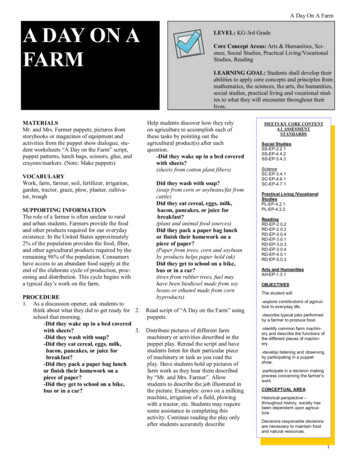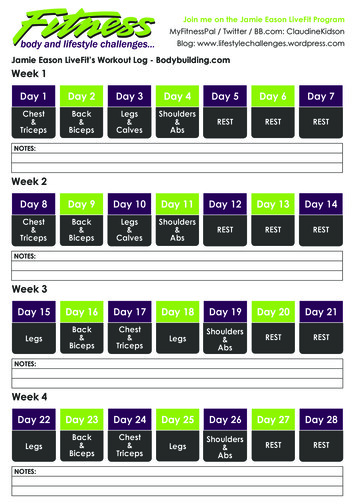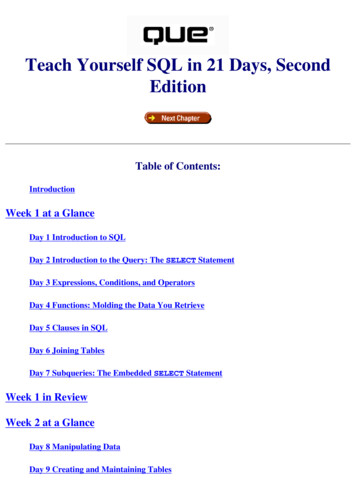
Transcription
A Day On A FarmA DAY ON AFARMMATERIALSMr. and Mrs. Farmer puppets, pictures fromstorybooks or magazines of equipment andactivities from the puppet show dialogue, student worksheets “A Day on the Farm” script,puppet patterns, lunch bags, scissors, glue, andcrayons/markers. (Note: Make puppets)VOCABULARYWork, farm, farmer, soil, fertilizer, irrigation,garden, tractor, graze, plow, planter, cultivator, troughSUPPORTING INFORMATIONThe role of a farmer is often unclear to ruraland urban students. Farmers provide the foodand other products required for our everydayexistence. In the United States approximately2% of the population provides the food, fiber,and other agricultural products required by theremaining 98% of the population. Consumershave access to an abundant food supply at theend of the elaborate cycle of production, processing and distribution. This cycle begins witha typical day’s work on the farm.PROCEDURE1. As a discussion opener, ask students tothink about what they did to get ready for 2.school that morning.-Did they wake up in a bed covered3.with sheets?-Did they wash with soap?-Did they eat cereal, eggs, milk,bacon, pancakes, or juice forbreakfast?-Did they pack a paper bag lunchor finish their homework on apiece of paper?-Did they get to school on a bike,bus or in a car?LEVEL: KG-3rd GradeCore Concept Areas: Arts & Humanities, Science, Social Studies, Practical Living/VocationalStudies, ReadingLEARNING GOAL: Students shall develop theirabilities to apply core concepts and principles frommathematics, the sciences, the arts, the humanities,social studies, practical living and vocational studies to what they will encounter throughout theirlives.Help students discover how they relyon agriculture to accomplish each ofthese tasks by pointing out theagricultural product(s) after eachquestion.-Did they wake up in a bed coveredwith sheets?(sheets from cotton plant fibers)Did they wash with soap?(soap from corn or soybeans/fat fromcattle)Did they eat cereal, eggs, milk,bacon, pancakes, or juice forbreakfast?(plant and animal food sources)Did they pack a paper bag lunchor finish their homework on apiece of paper?(Paper from trees, corn and soybeanby products helps paper hold ink)Did they get to school on a bike,bus or in a car?(tires from rubber trees, fuel mayhave been biodiesel made from soybeans or ethanol made from cornbyproducts)Read script of “A Day on the Farm” usingpuppets.Distribute pictures of different farmmachinery or activities described in thepuppet play. Reread the script and havestudents listen for their particular pieceof machinery or task as you read theplay. Have students hold up pictures offarm work as they hear them describedby “Mr. and Mrs. Farmer”. Allowstudents to describe the job illustrated inthe picture. Examples: cows on a milkingmachine, irrigation of a field, plowingwith a tractor, etc. Students may requiresome assistance in completing thisactivity. Continue reading the play onlyafter students accurately describeMEETS KY CORE CONTENT4.1 ASSESMENTSTANDARDSSocial EP-3.4.1SC-EP-4.6.1SC-EP-4.7.1Practical Living .3RD-EP-3.0.4RD-EP-4.0.1RD-EP-5.0.3Arts and HumanitiesAH-EP-1.3.1OBJECTIVESThe student will:-explore contributions of agriculture to everyday life.-describe typical jobs performedby a farmer to produce food.-identify common farm machinery and describe the functions ofthe different pieces of machinery.-develop listening and observingby participating in a puppetshow.-participate in a decision makingprocess concerning the farmer’swork.CONCEPTUAL AREAHistorical perspective –throughout history, society hasbeen dependent upon agriculture.Decisions-responsible decisionsare necessary to maintain foodand natural resources.1
A Day On A Farm(continued from page 1)the work done.4.To conclude the lesson, set up ahypothetical situation where studentshelp the farmer decide what work mustbe done. Example: “Students, early onemorning Mr. Farmer woke up, looked out his window on acold rainy day. He said, “I think I will sleep a few morehours before going to work.” What will happenif Mr. Farmer does not get up and go tothe barn to do his work?” In their decision making process,help the students recall that the cows are waiting to bemilked and fed and the milk truck will be arriving to get themilk. Many farm animals and people are depending uponthe farmer to do his work.RESOURCESScript and puppet patterns were adapted from the NorthCarolina Ag in the Classroom Curriculum Guide.EVALUATIONStudents demonstrate understanding of the concept of work.They can describe personal experiences which they may havehad with farm life– what is grown, what animals they have andhow they help with farm work. A concluding evaluation activitycould be to have students draw and color original pictures ofwhat they have learned about a day on a farm.2
A Day On A Farm“A Day on a Farm” ScriptMr. Farmer: A farmer’s day starts very early, usually before the sun comes up.Mrs. Farmer: I get up early also. I fix us breakfast before we begin our long day.Mr. Farmer: Farming is a very important job. All people must have food. Farmers grow food for people toeat. Each farmer grows enough food and fiber for 143 people in the United States and around the world.Mrs. Farmer: Before he eats breakfast, Mr. Farmer goes out and hooks up the milking machines to thecows. He then monitors each cow individually to ensure she’s comfortable and safe. He then gives thecows breakfast by pouring feed into their troughs.Mr. Farmer: While the cows are eating and being milked, I check on the garden. Afterwards, I go back tothe cows, unhook the milking machines, and see that the milk goes into the tanks. A milk truck will comehere later to pick the milk up.Mrs. Farmer: When Mr. Farmer returns we have breakfast. While we’re eating, we talk about what we’regoing to do today on the farm.Mr. Farmer: I need to test the soil today because this is very important. I’ll get a soil sample (that’s a littlebit of soil), put it in a small box, and send it to be tested. They’ll write me back and tell me what I need toput on the soil to make my crops grow bigger and better. I might need to add fertilizer to help my cropsgrow. Do you know what fertilizer is?Mrs. Farmer: Later today we have a meeting with someone to talk about irrigating our fields. When itdoesn’t rain much during the growing season, we have to water our crops. That is called irrigating. Wehave to find some way to water all of our fields. The hoses you use at home won’t stretch over all ourfields. We have to find another way, therefore we use irrigation systems. Have you ever helped waterplants?Mr. Farmer: Also, I need to check my equipment today to make sure it is in good condition. I use a tractor with a plow to loosen the soil before I plant. I also use a planter. Do you know what a planter does?The planter hooks on the back of the tractor and makes rows, then drops seeds and then covers them.Mrs. Farmer: Don’t forget the cultivator, honey. When weeds start to grow around the plants and between the rows the cultivator removes the weeds. Have you ever pulled weeds in a garden?Mr. Farmer: As you can see we have a very busy day ahead of us. Farming requires long hours. I amglad we love our farm because we use our good work habits. Mrs. Farmer is busy planning the work tobe done next week.Mrs. Farmer: Whew! I love my chosen career. Well, let’s get to work. You all have a nice day.3
A Day On A Farm4
A Day On A Farm5
A Day On A Farm6
A Day On A Farm7
puppet play. Reread the script and have students listen for their particular piece of machinery or task as you read the show. play. Have students hold up pictures of farm work as they hear them described by “Mr. and Mrs. Farmer”. Allow process concerning the farmer’s











